2018年海南卷 高考真题 英语
- 格式:doc
- 大小:90.50 KB
- 文档页数:11
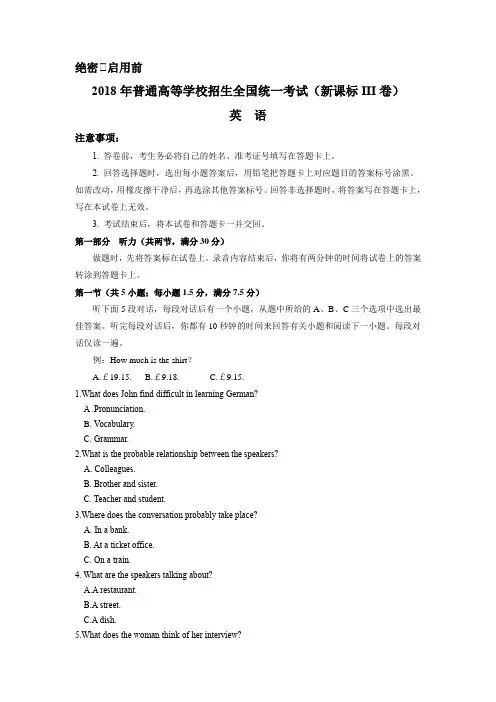
绝密★启用前2018年普通高等学校招生全国统一考试(新课标III卷)英语注意事项:1. 答卷前,考生务必将自己的姓名、准考证号填写在答题卡上。
2. 回答选择题时,选出每小题答案后,用铅笔把答题卡上对应题目的答案标号涂黑。
如需改动,用橡皮擦干净后,再选涂其他答案标号。
回答非选择题时,将答案写在答题卡上,写在本试卷上无效。
3. 考试结束后,将本试卷和答题卡一并交回。
第一部分听力(共两节,满分30分)做题时,先将答案标在试卷上。
录音内容结束后,你将有两分钟的时间将试卷上的答案转涂到答题卡上。
第一节(共5小题;每小题1.5分,满分7.5分)听下面5段对话,每段对话后有一个小题,从题中所给的A、B、C三个选项中选出最佳答案。
听完每段对话后,你都有10秒钟的时间来回答有关小题和阅读下一小题。
每段对话仅读一遍。
例:How much is the shirt?A.£19.15.B.£9.18.C.£9.15.1.What does John find difficult in learning German?A .Pronunciation.B.V ocabulary.C. Grammar.2.What is the probable relationship between the speakers?A. Colleagues.B. Brother and sister.C. Teacher and student.3.Where does the conversation probably take place?A. In a bank.B. At a ticket office.C. On a train.4. What are the speakers talking about?A.A restaurant.B.A street.C.A dish.5.What does the woman think of her interview?A. It was tough.B. It was interesting.C. It was successful.第二节(共15小题;每小题1.5分,满分22.5分)听下面5段对话或独白,每段对话或独白后有几个小题,从题中所给的A、B、C三个选项中选出最佳选项。
![[高考真题]2018年全国普通高等学校招生统一考试英语(新课标II卷)(原卷版)](https://uimg.taocdn.com/bb1d3580a1c7aa00b52acbb7.webp)
绝密★启用前2018年普通高等学校招生全国统一考试英语(考试时间:120分钟试卷满分:150分)注意事项:1. 答卷前,考生务必将自己的姓名、准考证号填写在答题卡上.2. 作答时,务必将答案写在答题卡上,写在本试卷及草稿纸上无效.3. 考试结束后,将本试卷和答题卡一并交回.第一部分听力做题时,先将答案标在试卷上.录音内容结束后,你将有两分钟的时间将试卷上的答案转涂到答题卡上.第一节听下面5短对话,每段对话后有一个小题,从题中给的A、B、C三个选项中选出最佳选项.听完每段对话后,你都有10秒钟的时间来回答有关小题和阅读下一小题.每段对话仅读一遍.例:How much is the shirt?A.£19.15.B.£9.18.C.£9.15.1. 音频What does John find difficult in learning German?A. Pronunciation.B. Vocabulary.C. Grammar.2. 音频What is the probable relationship between the speakers?A. Colleagues.B. Brother and sister.C. Teacher and student.3. 音频Where does the conversation probably take place?A. In a bank.B. At a ticket office.C. On a train.4. 音频What are the speakers talking about?A. A restaurant.B. A street.C. A dish.5. 音频What does the woman think of her interview?A. It was tough.B. It was interesting.C. It was successful.第二节听下面5段对话或独白,每段对话或独白后有几个小题,从题中所给的A、B、C三个选项中选出最佳选项.听每段对话或独白前,你将有时间阅读各个小题,每小题5秒钟;听完后,各小题将给出5秒钟的作答时间.每段对话或独白读两遍.听第6段材料,完成下面小题.音频6. When will Judy go to a party?A. On Monday.B. On Tuesday.C. On Wednesday.7. What will Max do next?A. Fly a kite.B. Read a magazine.C. Do his homework.听第7段材料,完成下面小题.音频8. What does the man suggest doing at first?A. Going to a concert.B. Watching a movie.C. Playing a computer game.9. What do the speakers decide to do?A. Visit Mike.B. Go boating.C. Take a walk.听第8段材料,完成下面小题.音频10. Which color do cats see better than humans?A. Red.B. Green.C. Blue.11. Why do cats bring dead birds home?A. To eat them in a safe place.B. To show off their hunting skills.C. To make their owners happy.12. How does the man sound at the end of the conversation?A. Grateful.B. Humorous.C. Curious.听第9段材料,完成下面小题.音频13. Who is Macy?A. Ed’s mother.B. Ed’s teacher.C. Ed’s friend.14. How does Ed usually go to kindergarten?A. By car.B. On foot.C. By bus.15. What does Ed enjoy doing at the kindergarten?A. Telling stories.B. Singing songs .C. Playing with others.16. What do the teachers say about Ed?A. He’s clever.B. He’s quiet.C. He’s brave.听第10段材料,完成下面小题.音频17. At what age did Emily start learning ballet?A. Five.B. Six.C. Nine.18. Why did Emily move to Toronto?A. To work for a dance school.B. To perform at a dance theater.C. To learn contemporary dance.19. Why did Emily quit dancing?A. She was too old to dance.B. She failed to get a scholarship.C. She lost interest in it.20. How does Emily feel about stopping training?A. She’s pleased.B. She’s regretful.C. She’s upset第二部分阅读理解第一节阅读下列短文,从每题所给的A、B、C和D四个选项中,选出最佳选项.ASummer ActivitiesStudents should read the list with their parents/carers, and select two activities theywould like to do. Forms will be available in school and online for them to indicate their choices and return to school. Before choices are finalised, parents/carers will be asked tosign to confirm their child’s choices.21. Which activity will you choose if you want to go camping?A. OUT.B. WBP.C. CRF.D. POT.22. What will the students do on Tuesday with Mrs. Wilson?A. Travel to London.B. See a parade and fireworks.C. Tour central Paris.D. Visit the WWI battlefields.23. How long does Potty about Potter last?A. Two days.B. Four days.C. Five days.D. One week.BMany of us love Ju ly because it’s the month when nature’s berries and stone fruits are in abundance. These colourful and sweet jewels form British Columbia’s fields are little powerhouses of nutritional protection.Of the common berries, strawberries are highest in vitamin C, although, because of their seeds, raspberries contain a little more protein (蛋白质), iron and zinc (not that fruits have much protein). Blueberries are particularly high in antioxidants (抗氧化物质). The yellow and orange stone fruits such as peaches are high in the carotenoids we turn into vitamin A and which are antioxidants. As for cherries (樱桃), they are so delicious who cares? However, they are rich in vitamin C.When combined with berries of slices of other fruits, frozen bananas make an excellent base for thick, cooling fruit shakes and low fat “ice cream”. For this purpose, select ripe bananas for freezing as they are much sweeter. Remove the skin and place them in plastic bags or containers and freeze. If you like, a squeeze of fresh lemon juice on the bananas will prevent them turning brown. Frozen bananas will last several weeks, depending on their ripeness and the temperature of the freezer.zx.x.kIf you have a juicer, you can simply feed in frozen bananas and some berries or sliced fruit. Out comes a “soft-serve” creamy dessert, to be eaten right away. This makes a fun activity for a children’s party; they love feeding the fruit and frozen bananas into the top of the machine and watching the ice cream come out below.24. What does the author seem to like about cherries?A. They contain protein.B. They are high in vitamin A.C. They have a pleasant taste.D. They are rich in antioxidants.25. Why is fresh lemon juice used in freezing bananas?A. To make them smell better.B. To keep their colour.C. To speed up their ripening.D. To improve their nutrition.26. What is “a juicer” in the last paragraph?A. A dessert.B. A drink.C. A container.D. A machine.27. From which is the text probably taken?A. A biology textbook.B. A health magazine.C. A research paper.D. A travel brochure.CTeens and younger children are reading a lot less for fun, according to a Common Sense Media report published Monday.While the decline over the past decade is steep for teen readers, some data in the report shows that reading remains a big part of many children’s liv es, and indicates how parents might help encourage more reading.According to the report’s key findings, “the proportion (比例) who say they ‘hardly ever’ read for fun has gone from 8 percent of 13-year-olds and 9 percent of 17-year-olds in 1984 to 22 pe rcent and 27 percent respectively today.”The report data shows that pleasure reading levels for younger children, ages 2—8, remain largely the same. But the amount of time spent in reading each session has declined, from closer to an hour or more to closer to a half hour per session.zxx.kWhen it comes to technology and reading, the report does little to counsel(建议) parents looking for data about the effect of e-readers and tablets on reading. It does point out that many parents still limit electronic reading, mainly due to concerns about increased screen time.The most hopeful data shared in the report shows clear evidence of parents serving as examples and important guides for their kids when it comes to reading. Data shows that kids and teens who do read frequently, compared to infrequent readers, have more books in the home, more books purchased for them, parents who read more often, and parents who set aside time for them to read.As the end of school approaches, and school vacation reading lists loom(逼近) ahead, parents might take this chance to step in and make their own summer reading list and plan a family trip to the library or bookstore.28. What is the Common Sense Media report probably about?A. Children’s reading habits.B. Quality of children’s books.C. Children’s after-class activities.D. Parent-child relationships.29. Where can you find the data that best supports "children are reading a lot less for fun"?A. In paragraph 2.B. In paragraph 3.C. In paragraph 4.D. In paragraph 5.30. Why do many parents limit electronic reading?A. E-books are of poor quality.B. It could be a waste of time.C. It may harm children’s health.D. E-readers are expensive.31. How should parents encourage their children to read more?A. Act as role models for them.B. Ask them to write book reports.C. Set up reading groups for them.D. Talk with their reading class teachers.DWe’ve all been there: in a lift, in line at the bank or on an airplane, surrounded by people who are, like us, deeply focused on their smartphones or, worse, struggling with the uncomfortable silence.What’s the problem? It’s possible that we all have compromised conversational intelligence. It’s more likely that none of us start a conversation because it’s awkward and challenging,or we think it’s annoying and unnecessary. But the next time you find yourself among strangers, consider that small talk is worth the trouble. Experts say it’s an invaluable social practice that results in big benefits.Dismissing small talk as unimporta nt is easy, but we can’t forget that deep relationships wouldn’teven exist if it weren’t for casual conversation. Small talk is the grease(润滑剂) for social communication, says Bernardo Carducci, director of the Shyness Research Institute at Indiana University Southeast. "Almost every great love story and each big business deal begins with small talk," he explains. "The key to successful small talk islearning how to connect with others, not just communicate with them."In a 2014 study, Elizabeth Dunn, associate professor of psychology at UBC, invited people on their way into a coffee shop. One group was asked to seek out an interaction(互动) with its waiter; the other, to speak only when necessary. The results showed that those who chatted with their server reported significantly higher positive feelings and a better coffee shop experience. "It’s not that ta lking to the waiter is better than talking to your husband," says Dunn. "But interactions with peripheral(边缘的) members of our social network matter for our well-being also."Dunn believes that people who reach out to strangers feel a significantly greater sense of belonging, a bond with others. Carducci believes developing such a sense of belonging starts with small talk. "Small talk is the basis of good manners," he says.32. What phenomenon is described in the first paragraph?A. Addiction to smartphones.B. Inappropriate behaviours in public places.C. Absence of communication between strangers.D. Impatience with slow service.33. What is important for successful small talk according to Carducci?A. Showing good manners.B. Relating to other people.C. Focusing on a topic.D. Making business deals.34. What does the coffee-shop study suggest about small talk?A. It improves family relationships.B. It raises people’s confidence.C. It matters as much as a formal talk.D. It makes people feel good.35. What is the best title for the text?A. Conversation CountsB. Ways of Making Small TalkC. Benefits of Small TalkD. Uncomfortable Silence第二节根据短文内容,从短文后的选项中选出能填入空白处的最佳选项.选项中有两项为多余选项.If you are already making the time to exercise, it is good indeed! With such busy lives, it can be hard to try and find the time to work out. ___36___ Working out in the morning provides additional benefits beyond being physically fit.Your productivity is improved. Exercising makes you more awake and ready to handle whatever is ahead of youfor the day.___37___Your metabolism(新陈代谢) gets a head start. ___38___ If you work out in the mornings, then you will be getting the calorie(卡路里)burning benefits for the whole day, not in your sleep.___39___ Studies found that people who woke up early for exercise slept better than those who exercised in the evening. Exercise energizes you, so it is more difficult to relax and have a peaceful sleep when you are very excited.___40___ If you work out bright and early in the morning, you will be more likely to stick to healthy food choices throughout the day. Who would want to ruin their good workout by eating junk food? You will want to continue to focus on positive choices.There are a lot of benefits to working out, especially in the mornings. Set your alarm clock an hour early and push yourself to work out! You will feel energized all day long.A. You will stick to your diet.B. Your quality of sleep improves.C. You prefer healthy food to fast food.D. There is no reason you should exercise in the morning.E. You can keep your head clear for 4-10 hours after exercise.F. After you exercise, you continue to burn calories throughout the day.G. If you are planning to do exercise regularly, or you’re doing it now, then liste n up!第三部分语言知识运用第一节完形填空阅读下面短文,从短文后各题所给的A、B、C和D四个选项中,选出可以填入空白处的最佳选项.Two weeks earlier , my son, Ben, had got in touch. He’d moved to England with his mum when he was three and it had been 13 years since I’d ___41___ seen him . So imagine my ___42___ when he emailed me saying he wanted to come to visit me.I was ___43___ ! I arrived early at Byron Bay where we were supposed to ___44___ . The bay was ___45___ in sunshine, and there was a group of kayakers around 150m off the shore. Getting a little ___46___ .I realized one kayak(皮划艇)was in ___47___ . “Something’s not ___48___ !” I took off my T-shirt and ___49___ into the water.I saw there were two instructors on board and a man lying across the middle. He was ___50___ violently. Linking arms with one of the instructors . I helped ___51___ the young man out of the water. He was unconscious and as I looked at his face, something ___52___ to me. Those brown eyes were very ___53___ . “What’s his name ?” I askedthe instructor. “Ben,” he replied, and immediat ely I ___54___ . That stranger was my son!The instructors called for an ambulance.___55___ ,after a brief stay in hospital, Ben was well enough to be allowed to ___56___ and later the family met up for dinner. We chatted about everything and then Ben___57___ to me. “I just want to say thank you,” he said, “You ___58___ my life !”I still can’t believe what a ___59___ it was. I’m just so glad I was there ___60___ to help my son.41. A. also B. often C. even D. last42. A. delight B. relief C. anger D. worry43. A. scared B. shocked C. thrilled D. ashamed44. A. talk B. stay C. meet D. settle45. A. bathed B. clean C. deep D. formed46. A. faster B. closer C. heavier D. wiser47. A. trouble B. advance C. question D. battle48. A. real B. right C. fair D. fit49. A. stared B. sank C. dived D. fell50. A. arguing B. fighting C. shouting D. shaking51. A. lead B. persuade C. carry D. keep52. A. happened B. occurred C. applied D. appealed53. A. sharp B. pleasant C. attractive D. familiar54. A. agreed B. hesitated C. doubted D. knew55. A. Fortunately B. Frankly C. Sadly D. Suddenly56. A. return B. relax C. speak D. leave57. A. joked B. turned C. listened D. pointed58. A. created B. honored C. saved D. guided59. A. coincidence B. change C. pity D. pain60. A. on board B. in time C. for sure D. on purpose第二节阅读下面短文,在空白处填入1个适当的单词或括号内单词的正确形式.Diets have changed in China — and so too has its top crop. Since 2011,the country ___61___(grow)more corn than rice. Corn production has jumped nearly 125 percent over ___62___ past 25 years, while rice has increasedonly 7 percent.A taste for meat is ___63___ (actual) behind the change: An important part of its corn is used to feed chickens, pigs, and cattle. Another reason for corn's rise: The government encourages farmers to grow corn instead of rice___64___ (improve) water quality. Corn uses less water ___65___ rice and creates less fertilizer(化肥) runoff. This switch has decreased ___66___ (pollute) in the country's major lakes and reservoirs and made drinking water safer for people.According to the World Bank, China accounts for about 30 percent of total ___67___ (globe)fertilizer consumption. The Chinese Ministry of Agriculture finds that between 2005—when the government ___68___ (start) a soil-testing program ___69___ gives specific fertilizer recommendations to farmers - and 2011, fertilizer use dropped by 7.7 million tons. That prevented the emission(排放) of 51.8 million tons of carbon dioxide. China's approach to protecting its environment while ___70___ (feed) its citizens "offers useful lessons for agriculture and food policymakers worldwide." says the bank's Juergen V oegele.第四部分写作第一节短文改错假定英语课上老师要求同桌之间交换修改作文,请你修改你同桌写的以下作文,文中共有10处语言错误,每句中最多有两处,每处错误仅涉及一个单词的增加、删除或修改.增加:在缺词处加一个漏字符号(Λ),并在其下面写出该加的词.删除:把多余的词用斜线(\)划掉.修改:在错的词下划一横线,并在该词下面写出修改后的词.注意:(1).每处错误及其修改均仅限一词;(2).只允许修改10处,多者(从第11处起)不计分.71. When I was little, Friday’s night was our family game night. After supper, we would play card games of all sort in the sitting room. As the kid, I loved to watch cartoons, but no matter how many times I asked to watching them, my parents would not to let me. They would say to us that playing card games would help my brain. Still I unwilling to play the games for them sometimes. I didn’t realize how right my parents are until I entered high school. The games my parents taught me where I was a child turned out to be very useful later in my life.第二节书面表达(满分25分)72. 你受学生会委托为校宣传栏“英语天地”写一则通知,请大家观看一部英语短片Growing Together,内容包括:(1)短片内容:学校的发展;(2)放映时间、地点;(3)欢迎对短片提出意见.注意:(1)词数100左右;(2)可以适当增加细节,以使行文连贯.。
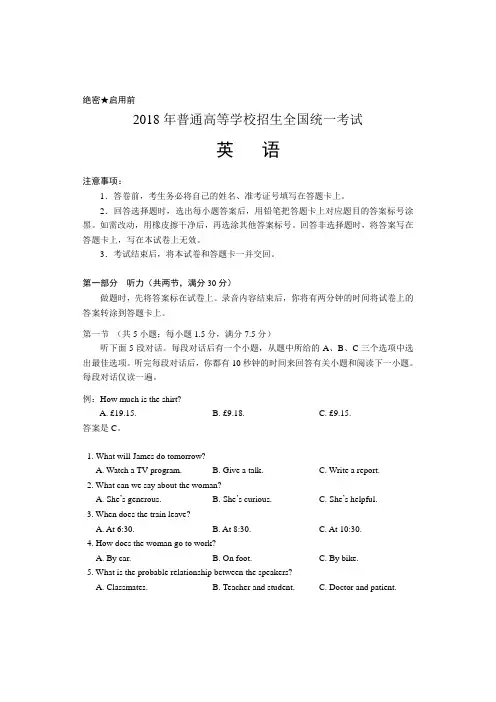
绝密★启用前2018年普通高等学校招生全国统一考试英语注意事项:1.答卷前,考生务必将自己的姓名、准考证号填写在答题卡上。
2.回答选择题时,选出每小题答案后,用铅笔把答题卡上对应题目的答案标号涂黑。
如需改动,用橡皮擦干净后,再选涂其他答案标号。
回答非选择题时,将答案写在答题卡上,写在本试卷上无效。
3.考试结束后,将本试卷和答题卡一并交回。
第一部分听力(共两节,满分30分)做题时,先将答案标在试卷上。
录音内容结束后,你将有两分钟的时间将试卷上的答案转涂到答题卡上。
第一节(共5小题;每小题1.5分,满分7.5分)听下面5段对话。
每段对话后有一个小题,从题中所给的A、B、C三个选项中选出最佳选项。
听完每段对话后,你都有10秒钟的时间来回答有关小题和阅读下一小题。
每段对话仅读一遍。
例:How much is the shirt?A. £19.15.B. £9.18.C. £9.15.答案是C。
1. What will James do tomorrow?A. Watch a TV program.B. Give a talk.C. Write a report.2. What can we say about the woman?A. She’s generous.B. She’s curious.C. She’s helpful.3. When does the train leave?A. At 6:30.B. At 8:30.C. At 10:30.4. How does the woman go to work?A. By car.B. On foot.C. By bike.5. What is the probable relationship between the speakers?A. Classmates.B. Teacher and student.C. Doctor and patient.第二节(共15小题;每小题1.5分,满分22.5分)听下面5段对话或独白。

2018 年普通高等学校招生全国统一考试(全国卷Ⅰ)英语第一部分听力(共两节,满分30 分)做题时,先将答案标在试卷上。
录音内容结束后,你将有两分钟的时间将试卷上的答案转涂到答题卡上。
第一节(共 5 小题;每小题 1.5 分,满分7.5 分)听下面 5 段对话。
每段对话后有一个小题,从题中所给的A、B、C 三个选项中选出最佳选项。
听完每段对话后,你都有10 秒钟的时间来回答有关小题和阅读下一小题。
每段对话仅读一遍。
例:How much is the shirt?A. £19.15.B. £9.18.C. £9.15.答案是C。
1. What will James do tomorrow?A. Watch a TV program.B. Give a talk.C. Write a report.2. What can we say about the woman?A. She’s generous.B. She’s curious.C. She’s helpful.3. When does the train leave?A. At 6:30.B. At 8:30.C. At 10:30.4. How does the woman go to work?A. By car.B. On foot.C. By bike.5. What is the probable relationship between the speakers?A. Classmates.B. Teacher and student.C. Doctor and patient.第二节(共15 小题;每小题 1.5 分,满分22.5 分)听下面 5 段对话或独白。
每段对话或独白后有几个小题,从题中所给的 A 、B、C 三个选项中选出最佳选项。
听每段对话或独白前,你将有时间阅读各个小题,每小题 5 秒钟;听完后,各小题将给出 5 秒钟的作答时间。
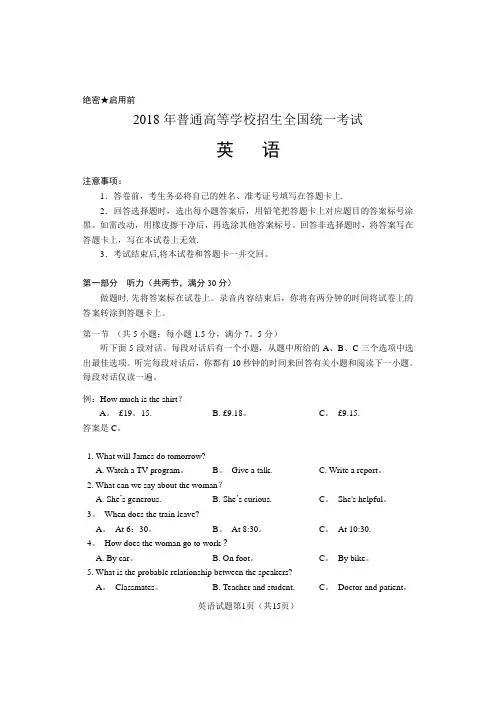
绝密★启用前2018年普通高等学校招生全国统一考试英语注意事项:1.答卷前,考生务必将自己的姓名、准考证号填写在答题卡上.2.回答选择题时,选出每小题答案后,用铅笔把答题卡上对应题目的答案标号涂黑。
如需改动,用橡皮擦干净后,再选涂其他答案标号。
回答非选择题时,将答案写在答题卡上,写在本试卷上无效.3.考试结束后,将本试卷和答题卡一并交回。
第一部分听力(共两节,满分30分)做题时,先将答案标在试卷上。
录音内容结束后,你将有两分钟的时间将试卷上的答案转涂到答题卡上。
第一节(共5小题;每小题1.5分,满分7。
5分)听下面5段对话。
每段对话后有一个小题,从题中所给的A、B、C三个选项中选出最佳选项。
听完每段对话后,你都有10秒钟的时间来回答有关小题和阅读下一小题。
每段对话仅读一遍。
例:How much is the shirt?A。
£19。
15. B. £9.18。
C。
£9.15.答案是C。
1. What will James do tomorrow?A. Watch a TV program。
B。
Give a talk. C. Write a report。
2. What can we say about the woman?A. She’s generous.B. She’s curious. C。
She's helpful。
3。
When does the train leave?A。
At 6:30。
B。
At 8:30。
C。
At 10:30.4。
How does the woman go to work?A. By car。
B. On foot。
C。
By bike。
5. What is the probable relationship between the speakers?A。
Classmates。
B. Teacher and student. C。
Doctor and patient。
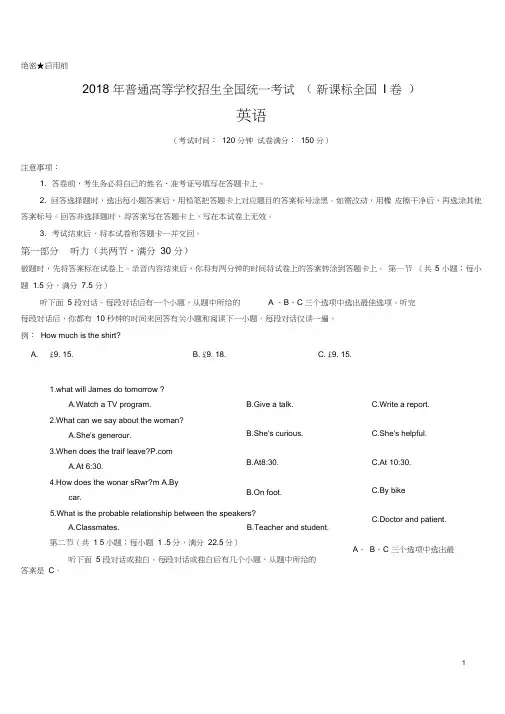
绝密★启用前2018 年普通高等学校招生全国统一考试(新课标全国I 卷)英语(考试时间:120 分钟试卷满分:150 分)注意事项:1. 答卷前,考生务必将自己的姓名、准考证号填写在答题卡上。
2. 回答选择题时,选出每小题答案后,用铅笔把答题卡上对应题目的答案标号涂黑。
如需改动,用橡皮擦干净后,再选涂其他答案标号。
回答非选择题时,将答案写在答题卡上,写在本试卷上无效。
3. 考试结束后,将本试卷和答题卡一并交回。
第一部分听力(共两节,满分30 分)做题时,先将答案标在试卷上。
录音内容结束后,你将有两分钟的时间将试卷上的答案转涂到答题卡上。
第一节(共5 小题;每小题 1.5 分,满分7.5 分)听下面 5 段对话。
每段对话后有一个小题,从题中所给的 A 、B、C 三个选项中选出最佳选项。
听完每段对话后,你都有10 秒钟的时间来回答有关小题和阅读下一小题。
每段对话仅读一遍。
例:How much is the shirt?A. £9. 15. 答案是C。
B. £9. 18.C. £9. 15.1.what will James do tomorrow ?A.Watch a TV program.2.What can we say about the woman?A.She's generour.3.When does the traif leave?A.At 6:30.4.How does the wonar sRwr?m A.Bycar. B.Give a talk. B.She's curious.B.At8:30.B.On foot.5.What is the probable relationship between the speakers?A.Classmates.B.Teacher and student. 第二节(共 1 5小题;每小题 1 .5分,满分22.5分)听下面 5 段对话或独白。
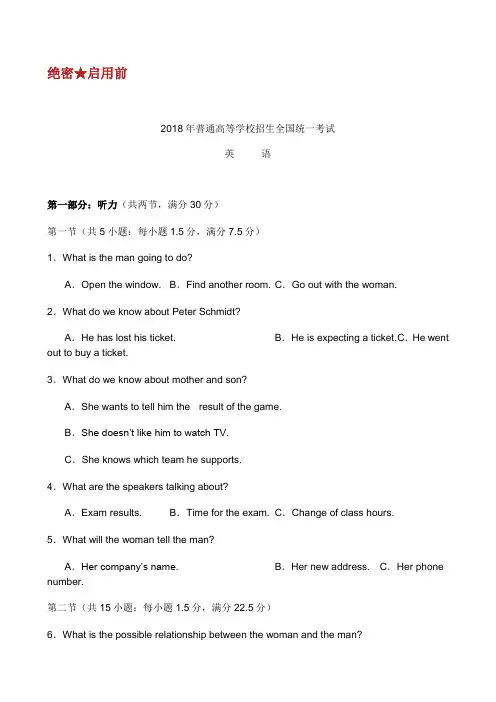
绝密★启用前2018年普通高等学校招生全国统一考试英语第一部分:听力(共两节,满分30分)第一节(共5小题:每小题1.5分,满分7.5分)1.What is the man going to do?A.Open the window. B.Find another room. C.Go out with the woman.2.What do we know about Peter Schmidt?A.He has lost his ticket. B.He is expecting a ticket. C.He went out to buy a ticket.3.What do we know about mother and son?A.She wants to tell him the result of the game.B.She doesn’t like him to watch TV.C.She knows which team he supports.4.What are the speakers talking about?A.Exam results. B.Time for the exam. C.Change of class hours.5.What will the woman tell the man?A.Her company’s name.B.Her new address. C.Her phone number.第二节(共15小题:每小题1.5分,满分22.5分)6.What is the possible relationship between the woman and the man?A.Wife and husband. B.Doctor and patient. C.Boss and secretary 7.What does the woman think about the man?A.He is not good to the children.B.He is not telling the truth.C.He sleeps too much.8.Where does the woman want to go?A.An office. B.A fruit shop. C.A police station. 9.What does the woman have to do now?A.Wait for Mark at the crossroads.B.Walk ahead and turn right.C.Walk a little way back.10.What exactly does the man want to find out?A.What people think of the bus service.B.How many people are using the bus service.C.Which group of people use the bus service most often.11.What does the woman say about the bus service?A.The distance between bus stops is too long.B.The bus timetables are full of mistakes.C.Buses are often not on time.12.Why does the woman say her husband is fortunate?A.He often goes to work in a friend’s car.B.He doesn’t need to go shopping by bus.C.He lives close to the bus station.13.What is the probable relationship between the two speakers?A.Salesperson and customerB.Old school friendsC.Fellow workers14.What do we know about the woman?A.She is fond of her work. B.She is tired of traveling. C.She is interested in law.15.What is the man?A.A company manager. B.A salesperson. C.A lawyer.16.Why does the woman ask for the man’s address?A.To send him a book.B.To get together with him.C.To repair something at his home.17.What is the aim of the program?A.To keep trainees in shape.B.To improve public relations.C.To develop leadership skills.18.Which of the following will the trainess be doing during the program?A.Attenling lectures on managementB.Preparing reports for the company.C.Making plans for a journey.19.How long will the program last?A.8 days B.12 days C.20 days.20.If people want to join the program, what should they do after the meeting?A.Take a pre-test B.Pay for the program. C.Sign on a piece of paper.第二部分:英语知识运用(共两节,满分45分)第一节:单项填空(共15小题:每小题1分,满分15分)21.Don’t be afraid of asking for help it is needed.A.unless B.since C.although D.when22.A cook will be immediately fired if he is found in the kitchen.A.smoke B.smoking C.to smoke D.smoked23.Allen had to call a taxi because the box was to carry all the way home.A.much too heavy B.too much heavy C.heavy too much D.too heavy much24.—Sorry, Joe, I didn’t mean to…—Don’t call me “Joe”. I’m Mr Parker to you, and you forget it!A.do B.didn’t C.did D.don’t25.If anybody calls, tell them I’m out, and ask them to their name and address.A.pass B.write C.take D.leave26.The sign reads “In case of fire, break the glass and push red button.”A.不填;a B.不填;the C.the; the D.a;a27.All morning as she waited for the medical report from the doctor, hernervouseness .A.has grown B.is growing C.grew D.had grown28.A left luggage office is a place where bags be left for a short time, especially at a railway station.A.should B.can C.must D.will29.We’re going to the bookstore in John’s car. You can come with us you can meet us there later.A.but B.and C.or D.then30.Why don’t you put the meat in the fridge? It will fresh for several days.A.be stayed B.stay C.be staying D.have stayed31.News reports say peace talks between the two countries with no agreement reached.A.have broken down B.have broken out C.have broken in D.have broken up32.—There’s coffee and tea: you can have .—Thanks.A.either B.each C.one D.it33.—Susan, go and join your sister cleaning the yard.—Why ? John is sitting there doing nothing.A.him B.he C.I D.me34.The old couple have been married for 40 years and never once with each other.A.they had quarreled B.they have quarreledC.have they quarreled D.had they quarreled35.—I think you should phone Jenny and say sorry to her.— .It was her fault.A.No way B.Not possible C.No chance D.Not at all第二节:完形填空(共20小题:每小题1.5分,满分30分)阅读下面短文,掌握其大意,然后从36—55各题所给的四个选项(A、B、C和D)中,选出最佳选项。
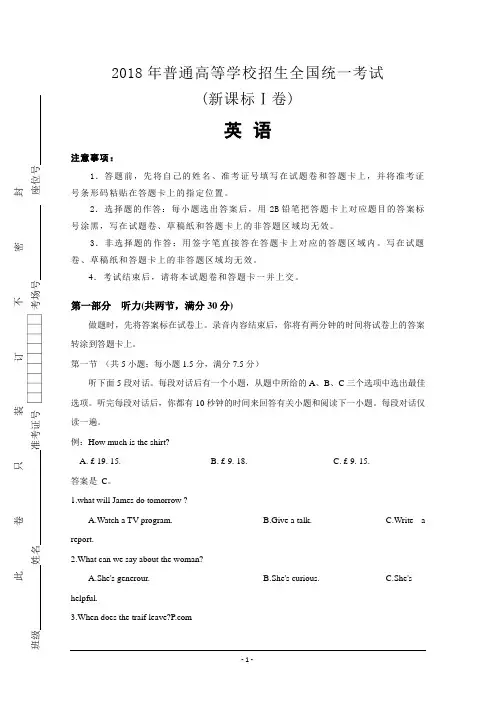
2018年普通高等学校招生全国统一考试(新课标Ⅰ卷)英 语注意事项:1.答题前,先将自己的姓名、准考证号填写在试题卷和答题卡上,并将准考证号条形码粘贴在答题卡上的指定位置。
2.选择题的作答:每小题选出答案后,用2B 铅笔把答题卡上对应题目的答案标号涂黑,写在试题卷、草稿纸和答题卡上的非答题区域均无效。
3.非选择题的作答:用签字笔直接答在答题卡上对应的答题区域内。
写在试题卷、草稿纸和答题卡上的非答题区域均无效。
4.考试结束后,请将本试题卷和答题卡一并上交。
第一部分 听力(共两节,满分30分)做题时,先将答案标在试卷上。
录音内容结束后,你将有两分钟的时间将试卷上的答案转涂到答题卡上。
第一节 (共5小题;每小题1.5分,满分7.5分)听下面5段对话。
每段对话后有一个小题,从题中所给的A 、B 、C 三个选项中选出最佳选项。
听完每段对话后,你都有10秒钟的时间来回答有关小题和阅读下一小题。
每段对话仅读一遍。
例:How much is the shirt? A. £ 19. 15.B. £ 9. 18.C. £ 9. 15.答案是 C 。
1.what will James do tomorrow ?A.Watch a TV program.B.Give a talk.C.Write areport.2.What can we say about the woman?A.She's generour.B.She's curious.C.She'shelpful.3.When does the traif leave?此卷只装订不密封级 姓名 准考证号 考场号 座位号A.At 6:30.B.At8:30.C.At 10:30.4.How does the wonar sRwr?mA.By car.B.On foot.C.By bike5.What is the probable relationship between the speakers?A.Classmates.B.Teacher and student.C.Doctor and patient.第二节(共15小题;每小题1.5分,满分22.5分)听下面5段对话或独白。
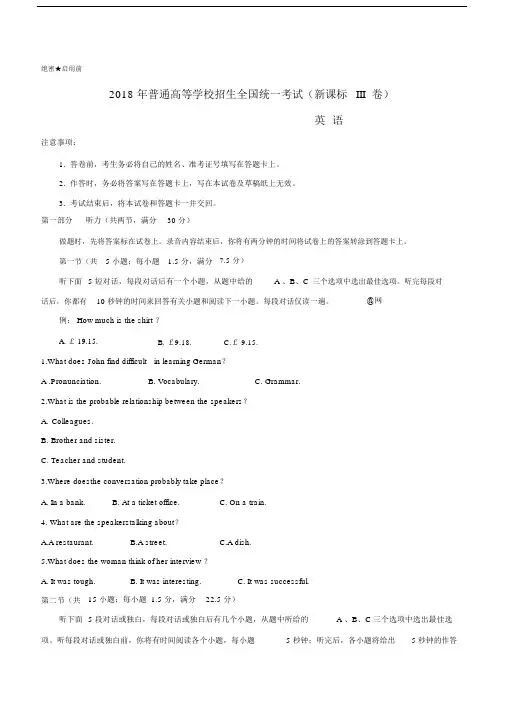
绝密★启用前2018 年普通高等学校招生全国统一考试(新课标III 卷)英语注意事项:1.答卷前,考生务必将自己的姓名、准考证号填写在答题卡上。
2.作答时,务必将答案写在答题卡上,写在本试卷及草稿纸上无效。
3.考试结束后,将本试卷和答题卡一并交回。
第一部分听力(共两节,满分30 分)做题时,先将答案标在试卷上。
录音内容结束后,你将有两分钟的时间将试卷上的答案转涂到答题卡上。
第一节(共 5 小题;每小题 1.5 分,满分7.5 分)听下面 5 短对话,每段对话后有一个小题,从题中给的 A 、B、C三个选项中选出最佳选项。
听完每段对话后,你都有10 秒钟的时间来回答有关小题和阅读下一小题。
每段对话仅读一遍。
@网例: How much is the shirt ?A. £ 19.15.B. £9.18.C.£ 9.15.1.What does John find difficultA .Pronunciation.in learning German?B. Vocabulary.C. Grammar.2.What is the probable relationship between the speakers?A.Colleagues.B.Brother and sister.C.Teacher and student.3.Where doesthe conversation probably take place?A. In a bank.B. At a ticket office.C. On a train.4. What are the speakerstalking about?A.A restaurant.B.A street.C.A dish.5.What does the woman think of her interview ?A. It was tough.B. It was interesting.C. It was successful.第二节(共15 小题;每小题 1.5 分,满分22.5 分)听下面 5 段对话或独白,每段对话或独白后有几个小题,从题中所给的 A 、B、C 三个选项中选出最佳选项。
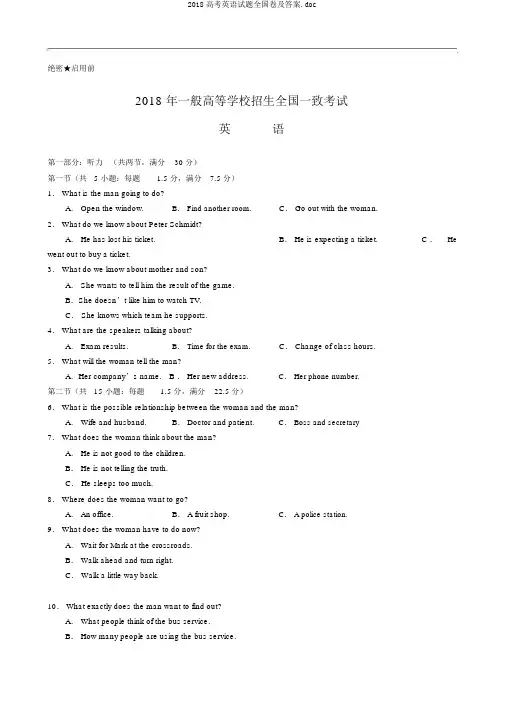
绝密★启用前2018 年一般高等学校招生全国一致考试英语第一部分:听力(共两节,满分30 分)第一节(共 5 小题:每题 1.5 分,满分7.5 分)1. What is the man going to do?A. Open the window.B. Find another room. 2. What do we know about Peter Schmidt?A. He has lost his ticket.went out to buy a ticket.3. What do we know about mother and son?A. She wants to tell him the result of the game.B.She doesn’t like him to watch TV.C. She knows which team he supports.4. What are the speakers talking about?A. Exam results.B. Time for the exam. 5. What will the woman tell the man?C. Go out with the woman.B. He is expecting a ticket. C .He C. Change of class hours.A.Her company’s name. B . Her new address.C. Her phone number.第二节(共15 小题:每题 1.5 分,满分22.5 分)6. What is the possible relationship between the woman and the man?A. Wife and husband.B. Doctor and patient.C. Boss and secretary 7. What does the woman think about the man?A. He is not good to the children.B. He is not telling the truth.C. He sleeps too much.8. Where does the woman want to go?A. An office.B. A fruit shop.C. A police station. 9. What does the woman have to do now?A. Wait for Mark at the crossroads.B. Walk ahead and turn right.C. Walk a little way back.10. What exactly does the man want to find out?A. What people think of the bus service.B. How many people are using the bus service.C. Which group of people use the bus service most often.11. What does the woman say about the bus service?A. The distance between bus stops is too long.B. The bus timetables are full of mistakes.C. Buses are often not on time.12. Why does the woman say her husband is fortunate?A.He often goes to work in a friend’s car.B.He doesn’t need to go shopping by bus.C. He lives close to the bus station.13. What is the probable relationship between the two speakers?A. Salesperson and customerB. Old school friendsC. Fellow workers14. What do we know about the woman?C.She is A. She is fond of her work.B. She is tired of traveling.interested in law.15. What is the man?A. A company manager.B. A salesperson.C. A lawyer.16. Why does the woman ask for the man’s address?A. To send him a book.B. To get together with him.C. To repair something at his home.17. What is the aim of the program?A. To keep trainees in shape.B. To improve public relations.C. To develop leadership skills.18. Which of the following will the trainess be doing during the program?A. Attenling lectures on managementB. Preparing reports for the company.C. Making plans for a journey.19. How long will the program last?A. 8 days B. 12 days C. 20 days.20. If people want to join the program, what should they do after the meeting?A. Take a pre-test B. Pay for the program.C. Sign on a piece of paper.第二部分:英语知识运用(共两节,满分45 分)第一节:单项填空(共15 小题:每题 1 分,满分15 分)21.Don’t be afraid of asking for help it is needed.A. unless B. since C. although D. when22. A cook will be immediately fired if he is found in the kitchen.A. smoke B. smoking C. to smoke D. smoked23. Allen had to call a taxi because the box was to carry all the way home.A. much too heavy B. too much heavy C. heavy too much D. too heavy much24.— Sorry, Joe, I didn’t mean to—Don’t call me“Joe”. I ’m Mr Parker to you, and you forget it!A. do B.didn ’t C. did D.don’t25.If anybody calls, tell them I’m out, and ask them to their name and address.A. pass B. write C. take D. leave26.The sign reads“In case of fire, break the glass and push redbutton.”A.不填; a B.不填; the C. the; the D. a;a27. All morning as she waited for the medical report from the doctor,her nervouseness.A. has grown B. is growing C. grew D. had grown28. A left luggage office is a place where bags be left for a short time, especially at a railway station.A. should B. can C. must D. will29.We’re going to the bookstore in John’s car. You can come with us you can meet us there later.A. but B. and C. or D. then30.Why don’t you put the meat in the fridge? It will fresh for several days.A. be stayed B. stay C. be staying D. have stayed31.Newsreports say peace talks between the two countries with no agreement reached.A. have broken down B. have broken out C. have broken in D.have broken up 32.— There’s coffee and tea: you can have.— Thanks.A. either B. each C. one D. it33.— Susan, go and join your sister cleaning the yard.— Why? John is sitting there doing nothing.A. him B. he C. I D. me34. The old couple have been married for 40 years and never once with each other.A. they had quarreled B. they have quarreledC. have they quarreled D. had they quarreled35.— I think you should phone Jenny and say sorry to her.—.It was her fault.A. No way B. Not possible C. No chance D. Not at all第二节:完形填空(共20 小题:每题 1.5 分,满分30 分)阅读下边短文,掌握其粗心,而后从36— 55 各题所给的四个选项(A、B、C 和 D)中,选出最正确选项。
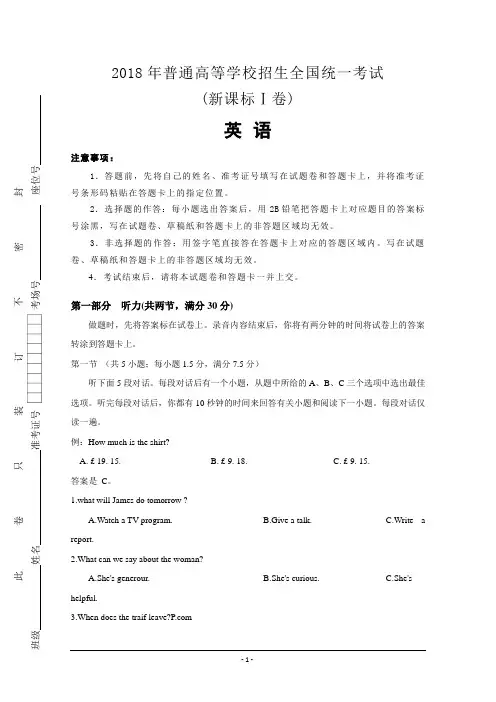
2018年普通高等学校招生全国统一考试(新课标Ⅰ卷)英 语注意事项:1.答题前,先将自己的姓名、准考证号填写在试题卷和答题卡上,并将准考证号条形码粘贴在答题卡上的指定位置。
2.选择题的作答:每小题选出答案后,用2B 铅笔把答题卡上对应题目的答案标号涂黑,写在试题卷、草稿纸和答题卡上的非答题区域均无效。
3.非选择题的作答:用签字笔直接答在答题卡上对应的答题区域内。
写在试题卷、草稿纸和答题卡上的非答题区域均无效。
4.考试结束后,请将本试题卷和答题卡一并上交。
第一部分 听力(共两节,满分30分)做题时,先将答案标在试卷上。
录音内容结束后,你将有两分钟的时间将试卷上的答案转涂到答题卡上。
第一节 (共5小题;每小题1.5分,满分7.5分)听下面5段对话。
每段对话后有一个小题,从题中所给的A 、B 、C 三个选项中选出最佳选项。
听完每段对话后,你都有10秒钟的时间来回答有关小题和阅读下一小题。
每段对话仅读一遍。
例:How much is the shirt? A. £ 19. 15.B. £ 9. 18.C. £ 9. 15.答案是 C 。
1.what will James do tomorrow ?A.Watch a TV program.B.Give a talk.C.Write areport.2.What can we say about the woman?A.She's generour.B.She's curious.C.She'shelpful.3.When does the traif leave?此卷只装订不密封级 姓名 准考证号 考场号 座位号A.At 6:30.B.At8:30.C.At 10:30.4.How does the wonar sRwr?mA.By car.B.On foot.C.By bike5.What is the probable relationship between the speakers?A.Classmates.B.Teacher and student.C.Doctor and patient.第二节(共15小题;每小题1.5分,满分22.5分)听下面5段对话或独白。
2018年普通高等学校招生全国统一考试(新课标I)英语听力(略)阅读理解(共两节,满分40分)第一节(共15小题,每小题2分,满分30分)阅读下列短文,从每题所给的A、B、C和D四个选项中,选出最佳选项。
ABicycle ToursCherry Blossom Bike Tour in 3 hoursThis small group bike tour is a fantastic way to see the world-famous cherry trees with beautiful flowers of Washington, . Your guide will provide a history lesson about the trees and the famous monuments where they blossom. Reserve your spot before availability - and the cherry blossoms - disappear!Washington Capital Monuments Bicycle TourDuration: 3 hours (4 miles)Join a guided bike tour and view some of the most popular monuments in Explore the monuments and memorials on the National Mall as your guide shares unique facts and history at each stop. Guided tour includes bike, helmet, cookies and bottled water.Capital City Bike Tour in Washington, .Duration: 3 hourMorning or Afternoon, this bike tour is the perfect tour for . newcomers and locals looking to experience Washington, a healthy way with minimum guides will entertain you with the most interesting stories about Presidents,Congress,memories,and bikes and a smooth tour route(路线) make cycling between the sites fun and relaxing.Washington Capital Sites at Night Bicycle TourDuration: 3 hour (7 miles)Join a small group hike tour for an evening of exploration in the heart of Washington,. Get up close to the monuments and memorials as you bike the sites of Capitol Hill and the National Mall. Frequent stops are made for photo taking as your guide offers unique facts and history. Tour includes bike, helmet, and bottled water. All riders are equipped with reflective vests and safety lights.21. Which tour do you need to book in advance 【A】A. Cherry Blossom Tour in Washington Capital Monuments Bicycle Tour.C. Capital City Bike Tour in Washington Capital Sites at Night Bicycle Tour.22. What will you do on the Capital City Bike Tour 【D】A. Meet famous people.B. Go to a national park.C. Visit well-known museums.D. Enjoy interesting stories.23. Which of the following does the bicycle tour at night provide 【D】A. City maps.B. CamerasC. Meals.D. Safety lights.BGood Morning Britain’s Susanna Reid is used to grilling guests on the sofa every morning,but she is cooking up a storm in her latest role-showing families how to prepare delicious and nutritious meals on a tight budget.In Save Money: Good Food,she visits a different home each week and with the help of chef Matt Tebbutt offers top tips on how to reduce food taste,while preparing recipes for under £5 per family a the Good Morning Britain presenter says she’s been able to put a lot of what she’s learnt into practice in her own home,preparing meals for sons,Sam,14,Finn,13,and Jack,11.“We love Mexican churros,so I buy them on my phone from my loc al Mexican takeaway restaurant,”she explains. “I pay £5 for a portion(一份),but Matt makes them for 26p a portion, because they are flour, water, sugar and oil. Everybody can buy takeaway food,but sometimes we’re not aware how cheaply we can make this food ourselves.”The eight-part series(系列节目),Save Money:Good Food,follows in the footsteps of ITV’s Save Money:Good Health,which gave viewers advice on how to get value from the vast range of health products on the market. With food our biggest weekly household expense,Susanna and Matt spend time with a different family each tonight’s Easter special they come to the aid of a family in need of some delicious inspiration on a team transforms the family’s long weekend of celebration with less expensive but still tasty recipes.do we know about Susanna Reid (B)enjoys embarrassing her guests. has started a new programme.dislikes working early in the morning. has had a tight budget for her family.does Matt Tebbutt help Susanna (C)buys cooking materials for her. prepare food for her kids.assists her in cooking matters. invites guest families for her.does the author intend to do in paragraph 4 (C)the previous paragraphs. some advice for the readers.some background information. a new topic for discussion.can be a suitable title for the text (D)Fit by Eating Smart Our Daily DietYourself a Perfect Chef Well for LessCLanguages have been coming and going for thousands of years,but in recent times there has been less coming and a lot more the world was still populated by hunter-gatherers,small,tightly knit(联系) groups developed their own patterns of speech independent of each language experts believe that 10,000 years ago,when the world had just five to ten million people,they spoke perhaps 12,000 languages between them.Soon afterwards,many of those people started settling down to become farmers,and their languages too became more settled and fewer in recent centuries,trade,industrialisation,the development of the nation-state and the spread of universal compulsory education,especially globalisation and better communications in the past few decades,all have caused many languages to disappear,and dominant languages such as English,Spanish and Chinese are increasingly taking over.At present, the world has about 6,800 languages. The distribution of these languages is hugely uneven. The general rule is that mild zones have relatively few languages, often spoken by many people, while hot, wet zones have lots, often spoken by small numbers. Europe has only around 200 languages; the Americas about 1,000; Africa 2,400; and Asia and the Pacific perhaps 3,200, of which Papua New Guinea alone accounts for well over 800. The median number (中位数)of speakers i s a mere 6,000,which means that half the world’s languages are spoken by fewer people than that.Already well over 400 of the total of 6,800 languages are close to extinction (消亡), with only a few elderly speakers left. Pick, at random, Busuu in Cameroon (eight remaining speakers), Chiapaneco in Mexico (150), Lipan Apache in the Unitde States (two or three) or Wadjigu in Auatralia (one, with a question-mark): none of these seems to have much chance of survival.can we infer about languages in hunter-gatherer times Bdeveloped very fast. were large in number.had similar patterns. were closely connected.of the following best explains “dominan t” underlined in paragraph 2C. . .many languages are spoken by less than 6,000 people at present B6,800. 3,400. 2,400. 1,200.is the main idea of the text Clanguages will be created.’s lifestyles are reflected in languages.development results in fewer languages.determines language evolution.DWe may th ink we’re a culture that gets rid of our worn technology at the first sight of something shony and new,but a new study shows that we keep using our old devices (装置) well after they go out of style,That’s bad news for environment – and our wallets – as these outdated devices consume much more energy than the newer ones that do the same things.To figure out how much power these devices are using,Callie Babbitt and her colleagues at the Rochester Institute of Technology in New York tracked the environmental costs for each product throughout its life – form when its minerals are mined to when we stop using the method provided a readout for how home energy use evolved since the early were grouped by computers, basic mobile phones,and box-set TVs defined 1992. Digital cameras arrived on the scene in 1997. And MP3 players, smart phones, and LCD TVs entered homes in 2002, before tablets and e-readers showed up in 2007.As we accumulated more devices,however,we didn’t throw out our old ones.“The Living-room television is replaced and gets planted in the kid’s room ,and suddenly one day,you have a TV in every room of the house,”said one researcher. The average number of electronic devices rose from four per household in 1992 to 13 in ’re not just keeping these old devices-we continue to use them. According to the analysis of Babbin’s team,old desktop monitors and box TV’s with cathode ray tubes are the worst devices with their energy consumption and contribution to greenhouse gas emissions(排放) more than doubling during the 1992 to 2007 window.So what’s the solution(解决方案) The team’s data only went up to 2007,but the researchers also explored what would happen if consumers replaced old products with new electronics that serve more than one function ,such as a tablet for word processing and TV viewing. They found that more on-demand entertainment viewing on tablets instead of TVs and desktop computers could cut energy consumption by 44%.does the author think of new devices (A)are environment-friendly. are no better than the old.cost more to use at home. go out of style quickly.did Babbin’s team conduct the research(D)reduce the cost of minerals. test the life cycle of a product.update consumers on new technology. find out electricity consumption of the devices.of the following uses the least energy(B)box-set TV. table t. LCD TV. desktop computer.does the text suggest people do about old electronic devices(A)using them. B. Take them apart. them. them.第二节(共5小题,每小题2分,满分10分)根据短文内容,从短文后的选项中选出能填入空白处的最佳选项,选项中有两项为多余选项。
2018年普通高等学校招生全国统一考试(I卷)英语(考试时间:120分钟试卷满分:150分)第二部分阅读理解(共两节,满分40分)第一节(共15小题;每小题2分,满分30分)阅读下列短文,从每题所给的A、B、C和D四个选项中,选出最佳选项。
AWashington, D.C. Bicycle ToursCherry Blossom Bike Tour in Washington, D.C.Duration TourThis small group bike tour is a fantastic way to see a world-famous cherry trees with beautiful flowers of Washington, D.C. Your guide will provide a history lesson about the trees and the famous monuments where they blossom. Reserve your spot before availability —the cherry blossoms—disappear!Washington Capital Monuments Bicycle TourDuration:3 hours (4 miles)Join a guided bike tour and view some of the most popular monuments in Washington, D.C. Explore the monuments and memorials on the National Mall as your guide shares unique facts and history at each stop. Guided tour includes bike, helmet, cookies and bottled water.Capital City Bike Tour in Washington, D.C.Duration:3 hoursMorning or Afternoon, this bike tour is the perfect tour for D. C. newcomers and locals looking to experience Washington, D.C. in a healthy way with minimum effort. Knowledgeable guides will entertain you with the most ,interesting stories about Presidents, Congress, memorials, and parks. Comfortable bikes and a smooth tour route(路线)make cycling between the sites fun and relaxing.Washington Capital Sites at Night Bicycle TourDuration:3 hours(7miles)Join a small group bike tour for an evening of exploration in the heart of Washington, D.C. Get up close to the monuments and memorials as you bike the sites of Capitol Hill and the National Mall. Frequent stops are made for photo taking as your guide offers unique facts and history. Tour includes bike, helmet, and bottled water. All riders are equipped with reflective vests and safety lights.21.Which tour do you need to book in advance?A. Cherry Blossom Bike Tour in Washington, D.C.B. Washington Capital Monuments Bicycle Tour.C. Capital City Bike Tour in Washington,D.C.D. Washington Capital Sites at Night Bicycle Tour.22.What will you do on the Capital City Bike Tour?A. Meet famous people.B. Go to a national park.C. Visit well-known museums.D. Enjoy interesting stories.23.Which of the following does the bicycle tour at night provide?A. City maps.B. Cameras.C. Meals.D. Safety lights.【答案】21. A 22. D 23. D【解析】本文是一篇广告应用文。
2018年普通高等学校招生全国统一考试(课标全国卷Ⅲ)英语第一部分听力(共两节,满分30分)第二部分阅读理解(共两节,满分40分)第一节(共15小题;每小题2分,满分30分)阅读下列短文,从每题所给的A、B、C和D四个选项中,选出最佳选项。
AWelcome to Holker Hall & GardenVisitor InformationHow to Get to HolkerBy car: Follow brown signs on A590 from. J36, M6. Approximate travel times: Windermere—20 minutes, Kendal—25 minutes, Lancaster—45 minutes, Manchester—l hour 30minutesBy rail: the nearest station is Cark-in-Cartmel with trains to Carnforth. Lancaster and Preston for connections to major cities & airports.Opening timesSunday-Friday(closed on Saturday) 11:00 am-4;00pm, 30 March-2nd November.Admission ChargesHall & Gardens GardensAdults: £12.00 £8.00Gropes: £9.00Special EventsProducers Market 13th AprilJoin us to taste a variety of fresh local food and drinks. Meet the producers and get some excellent recipe ideas.Holker Garden Festival 30th MayThe event celebrates its 22nd anniversary with a great show of the very best of gardening, making it one of the most popular events in the gardening.National Garden Day 28th AugustHolker once again opens its gardens in aid of the disadvantaged. For just a small donation you can takea tour with our garden guide.Winter Market 8th NovemberThis is an event for all the family! Wander among a variety of shops selling gifts while enjoying a livemusic show and nice street entertainment.21. How long does it probably take a tourist to drive to Holker from Manchester?A.20 minutes.B. 25 minutes.C.45 minutes.D. 90 minutes.22. How much should a member of a tour group pay a visit to Hall & Gardens?9.00. C. £5.508.00 D. £A. £12.00. B. £23. Which event will you go to if you want to see a live music show?A. Producers Market.B. Holker Garden FestivalC. National Garden Day.D. Winter MarketBCities usually have a good reason for being where they are, like a nearby port on river. People settle in these places because they are easy to get to and naturally suited to communications and trade. New York City, for example, is near a large harbour at the mouth of the Hudson River. Over 300 years its population grew graduallyfrom 800 people to 8 million. But not all cities develop slowly over a long period of time. Boom towns grow from nothing almost overnight. In 1896 Dawson Canada was unmapped wilderness(荒野). But gold was discovered there in 1897 and two years later, it was one of the largest cities in the West, with a population of 30,000.Dawson did not have any of the natural conveniences of cities like London or Paris. People went there for gold. They travelled over snow-covered mountains and sailed hundreds of miles up icy rivers. The path to Dawson was covered with thirty feet of wet snow that could fall without warning. An avalanche (雪崩) once closed the path, killing 63 people. For many who made it to Dawson, however, the rewards were worth the difficult trip. Of the first 20,000 people who dug for gold, 4,000 got rich. About 100 of these stayed rich men for the rest of their lives.But no matter how rich they were, Dawson was never comfortable. Necessities like food and wood were very expensive. But soon, the gold that Dawson depended on had all been found. The city was crowded with disappointed people with no interest in settling down, and when they heard there were new gold discoveries in Alaska, they left Dawson City as quickly as they had come. Today, people still come and go to see where the Canadian gold rush happened. Tourism is now the chief industry of Dawson City - its present population is 762.24. What attracted the early settlers to New York City?A. Its business culture.B. Its small population.C. Its geographical position.D. Its favourable climate.25. What do we know about those who first dug for gold in Dawson?A. Two thirds of them stayed there.B. One out of five people got rich.C. Almost everyone gave up.D. Half of them died.26. What was the main reason for many people to leave Dawson?A. They found the city too crowded.B. They wanted to try their luck elsewhere.C. They were unable to stand the winter.D. They were short of food.27. What is the text mainly about?A. The rise and fall of a city.B. The gold rush in Canada.C. Journeys into the wilderness.D. Tourism in Dawson.CWhile famous foreign, architects are invited to lead the designs of landmark buildings in China such as thenew CCTV tower and the National Center for the Performing Arts, many excellent Chinese architects are making great efforts to take the center stage.Their efforts have been proven fruitful. Wang Shu a 49-year-old Chinese architect, won the 2012 Pritzker Architecture Prize -which is often referred to as the Nobel Prize in architecture--on February 28. He is the first Chinese citizen to win this award.Wang serves as head of the Architecture Department at the China Department at the China Academy of Art(CAA). His office is located at the Xiangshan campus (校园)of the university in Hangzhou, Zhejiang Province. Many buildings on the campus are his original creations.The style of the campus is quite different from that of most Chinese universities. Many visitors were amazedby the complex architectural space and abundant building types. The curves (曲线)of the buildings perfectly match the rise and fall of hills, forming a unique view.Wang collected more than 7 million abandoned bricks of different ages. He asked the workers to use traditional techniques to make the bricks into walls, roofs and corridors. This creation attracted a lot of attention thanks to its mixture of modern and traditional Chinese elements.Wang’s works show a deep understanding of modern architecture and a good knowledge of traditions. Through such a balance, he had created a new type of Chinese architecture, said Tadao Ando, the winner of the1995 Pritzker Prize.Wang believes traditions should not be sealed in glass boxes at museums. “That i s only evidence that traditions once existed, “ he said.“Many Chinese people have a misunderstanding of traditions. They think tradition means old things from the past. In fact, tradition also refers to the things that have been developing and that are still being created,“Today, many Chinese people are learning Western styles and theories rather than focusing on Chinese traditions. Many people tend to talk about traditions without knowing what they really are," said Wang.The study of traditions should be combined, with practice. Otherwise, the recreation of traditions would be artificial and empty, he said.28. Wang's winning of the prize means that Chinese architects areA. following the latest world trendB. getting international recognitionC. working harder than ever beforeD. relying on foreign architects29. What impressed visitors to the CAA Xiangshan campus most?A. Its hilly environment.B. Its large sizeC. Its unique style.D. Its diverse functions.30. What made Wang's architectural design a success?A. The mixture of different shapes.B. The balance of East and WestC. The use of popular techniquesD. The harmony of old and new.31. What should we do about Chinese traditions according to Wang?A. Spread them to the world.B. Preserve them at museums.C. Teach them in universities.D. Recreate them in practice.DAdults understand what if feels like to be flooded with objects. Why do we often assume that more is more when it comes to kids and their belongings? The good news is that I can help my own kids learn earlier than Idid how to live more with less.I found the pre-holidays a good time to encourage young children to donate less-used things, and it worked. Because of our efforts, our daughter Georgia did decide to donate a large bag of toys to a little girl whose motherwas unable to pay for her holiday due to illness. She chose to sell a few large objects that were less often used when we promised to put the money into her school fund (基金) (our kindergarten is serious about becoming a doctor).For weeks, I’ve been thinking of bigger, deeper questions. How do we make it a habit for them? And how do we train ourselves to help them live with, need and use less? Yesterday, I sat with my son, Shepherd, determined to test my own theory on this. I decided to play with him with only one toy for as long as it would keep his interest. I expected that one toy would keep his attention for about five minutes, ten minutes max. I chose a red rubber ball-simple, universally available. We passed it, he tried to put it in his mouth, he tried bouncing it, rolling it, sittingon it, throwing it. It was totally, completely enough for him. Before I knew it an hour had passed and it was time to move on to lunch.We both became absorbed in the simplicity of playing together. He had my full attention and I had his. Mylittle experiment to find joy in a single object worked for both of us.32. What do the words “more is more” in paragraph 1 probably mean?A. The more, the better.B. Enough is enough.C. More money, more worries.D. Earn more and spend more.33. What made Georgia agree to sell some of her objects?A. Saving up for her holiday.B. Raising money for a poor girl.C. Adding the money to her fund.D. Giving the money to a sick mother.34. Why did the author play the ball with Shepherd?A. To try out an idea.B. To show a parent’s love.C. To train his attention.D. To help him start a hobby,.35. What can be a suitable title for the text?A. Take it or Leave it.B. A Lesson from Kids.C. Live More with Less.D. The Pleasure of Giving.第二节(共5小题;每小题2分,满分10分)根据短文内容,从短文后的选项中选出能填入空白处的最佳选项。
第一部分 听力(共两节,满分30分) 第一节(共5小题;每小题分,满分分) 听下面5短对话,每段对话后有一个小题,从题中给的A、B、C三个选项中选出最佳选项。听完每段对话后,你都有10秒钟的时间来回答有关小题和阅读下一小题。每段对话仅读一遍。 例:How much is the shirt A. £. B. £. C. £. 1. What does John find difficult in learning German A. Pronunciation. B. Vocabulary. C. Grammar. 2. What is the probable relationship between the speakers A. Colleagues. B. Brother and sister. C. Teacher and student. 3. Where does the conversation probably take place A. In a bank. B. At a ticket office. C. On a train. 4. What are the speakers talking about A. A restaurant. B. A street. C. A dish. does the woman think of her interview A. It was tough. B. It was interesting. C. It was successful. 第二节(共15小题;每小题分,满分分) 听下面5段对话或独白,每段对话或独白后有几个小题,从题中所给的A、B、C三个选项中选出最佳选项。听每段对话或独白前,你将有时间阅读各个小题,每小题5秒钟;听完后,各小题将给出5秒钟的作答时间。每段对话或独白读两遍。 听第6段材料,回答第6、7题。 6. When will Judy go to a party A. On Monday. B. On Tuesday. C. On Wednesday. 7. What will Max do next A. Fly a kite. B. Read a magazine. C. Do his homework. 听第7段材料,回答第8、9题。 8. What does the man suggest doing at first A. Going to a concert. B. Watching a movie. C. Playing a computer game. 9. What do the speakers decide to do A. Visit Mike. B. Go boating. C. Take a walk. 听第8段材料,回答第10至12题。 10. Which color do cats see better than humans A. Red. B. Green. C. Blue. 11. Why do cats bring dead birds home A. To eat them in a safe place. B. To show off their hunting skills. C. To make their owners happy. 12. How does the man sound at the end of the conversation A. Grateful. B. Humorous. C. Curious. 听第9段材料,回答第13至16题。 13. Who is Macy A. Ed’s mother. B. Ed’s teacher. C. Ed’s friend. 14. How does Ed usually go to kindergarten A. By car. B. On foot. C. By bus. 15. What does Ed enjoy doing at the kindergarten A. Telling stories. B. Singing songs. C. Playing with others. 16. What do the teachers say about Ed A. He’s clever. B. He’s quiet. C. He’s brave. 听第10段材料,回答第17至20题。 17. At what age did Emily start learning ballet A. Five. B. Six. C. Nine. 18. Why did Emily move to Toronto A. To work for a dance school. B. To perform at a dance theater. C. To learn contemporary dance. 19. Why did Emily quit dancing A. She was too old to dance. B. She failed to get a scholarship. C. She lost interest in it. 20. How does Emily feel about stopping training A. She’s pleased. B. She’s regretful. C. She’s upset. 第二部分 阅读理解(共两节,满分40分) 第一节 (共15小题;每小题2分,满分30分) 阅读下列短文,从每题所给的A、B、C和D四个选项中,选出最佳选项。 A Summer Activities Students should read the list with their parents/carers, and select two activities they would like to do. Forms will be available in school and online for them to indicate their choices and return to school. Before choices are finalised, parents/carers will be asked to sign to confirm their child’s choices. Activity Description Member of Cost staff Outdoor Adventure (OUT) Take yourself out of your comfort zone for a week, discover new personal qualities, and learn new skills. You will be able to take part in a number of activities from canoeing to wild camping on Dartmoor. Learn rock climbing and work as a team, and enjoy the great outdoor environment. Mr. Clemens £140
WWI Battlefields and Paris (WBP) On Monday we travel to London. After staying overnight in London, we travel on Day 2 to northern France to visit the World War I battlefields. On Day 3 we cross into Belgium. Thursday sees us make the short journey to Paris where we will visit Disneyland Paris park, staying until late to see the parade and the fireworks. Our final day, Friday, sees us visit central Paris and tour the main sights. Mrs. Wilson £425
Crafty Foxes (CRF) Four days of product design centred around textiles. Making lovely objects using recycled and made materials. Bags, cushions and decorations...Learn skills and leave with modern and unusual textiles. Mrs. Goode £30 Potty about Potter (POT) Visit Warner Bros Studio, shop stop to buy picnic, stay overnight in an approved Youth Hostel in Streatley-on -Thames, guided tour of Oxford to see the film locations, picnic lunch outside Oxford’s Christchurch, boating on the River Cherwell through the University Parks, before heading back to Exeter. Miss Drake £150
21. Which activity will you choose if you want to go camping A. OUT. B. WBP. C. CRF. D. POT. 22. What?will?the?students?do?on?Tuesday?with?Mrs.?Wilson A. Travel?to?London.?? B. See?a?parade?and?fireworks. C. Tour?central?Paris. D. Visit?the?WWI?battlefields. 23. How?long?does?Potty?about?Potter?last A. Two?days. B. Four?days. C. Five?days. D. One?week. B Many of us love July because it’s the month when nature’s berries and stone fruits are in abundance. These colourful and sweet jewels from British Columbia’s fields are little powerhouses of nutritional protection. Of the common berries, strawberries are highest in vitamin C, although, because of their seeds, raspberries contain a little more protein(蛋白质), iron and zinc (not that fruits have much protein). Blueberries are particularly high in antioxidants(抗氧化物质). The yellow and orange stone fruits such as peaches are high in the carotenoids we turn into